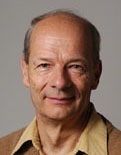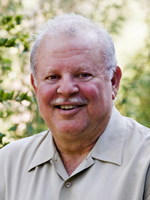Invited Talks
1. Keynote Presentation
Title: Taking the "Virtual" Out of Virtual Reality
Speaker: Carlo H Sequin

Abstract
Today's graphics programs cannot only produce stunning photo-realistic images or convincingly real scene displays for interactive exploration, they can also produce physical output -- thanks to the emergence of several different layered manufacturing technologies. For many design activities creating tangible models through some rapid-prototyping prcess is a new and crucial feedback loop for debugging the functionality or customer-appeal of a new product.
Dr. Séquin has two decades of experience with creating mathematical visualization models
and designs ranging from university buildings to abstract geometrical sculptures. Turning these virtual creations into physical realities, however, raises a whole new set of issues that are often overlooked in the initial virtual design phase.
Biography
Carlo H. Séquin is a professor of Computer Science at the University of California, Berkeley. He received his Ph.D. degree in experimental physics from the University of Basel, Switzerland in 1969. From 1970 till 1976 he worked at Bell Telephone Laboratories, Murray Hill, NJ, on the design and investigation of Charge-Coupled Devices for imaging and signal processing applications. At Bell Labs he also got introduced to the world of Computer Graphics in classes given by Ken Knowlton.
In 1977 he joined the faculty in the EECS Department at Berkeley. He started out by teaching courses on the subject of very large-scale integrated (VLSI) circuits, thereby building a bridge between the CS division and the EE faculty. In the early 1980's, jointly with Dave Patterson, he introduced the `RISC' concept to the world of microcomputers. He was head of the Computer Science Division from 1980 till 1983. Since then he has concentrated on computer graphics, geometric modeling, and on the development of computer aided design (CAD) tools for circuit designers, architects, and for mechanical engineers. Around 1990 he served as the head of the building committee for the new Computer Science Building at U.C.Berkeley. In that context, together with his students, he developed an efficient walk-through program for virtual buildings; some of the techniques developed for this purpose are still used in interactive video games today.
For more than two decades, Dr. Séquin has also been teaching courses in creative geometric modeling and in procedural object generation. In these classes students explore subjects ranging from the geometry of gear wheel assemblies, or the fractal-based modeling of plants, to the generation of virtual museums filled with mathematical visualization models. More recently he has added a rapid-prototyping component to these classes and now pursues the goal ofo streamlining the path from a creative idea to a first demonstrable model.
Since the mid-1990's, Séquin's work in computer graphics and in geometric design have provided a bridge to the world of art. In collaboration with a few sculptors of abstract geometric art, in particular with Brent Collins of Gower, MO, Séquin has found yet another domain where new frontiers can be opened through the use of computer-aided tools. Large bronze sculptures resulting from collaborations between Brent Collins, Steve Reinmuth of the Bronze Studio in Eugene, OR, and Carlo Séquin have been installed in the lobby of Sutardja Dai Hall at U.C. Berkeley and in the courtyard of the H&R Block headquarters building in Kansas City.
Dr. Séquin is a Fellow of the ACM, a Fellow of the IEEE, and has been elected to the Swiss Academy of Engineering Sciences. He has received the IEEE Technical Achievement Award for contributions to the development of computer-aided design tools, the Diane S. McEntyre Award for Excellence in Teaching, and an Outstanding Service Award from the University of California for Exceptional Leadership in the Conception, Design and Realization of Soda Hall.
2. Banquet Presentation
Title: What's Next?: The Third Wave in Computer Graphics and Interactive Techniques
Speaker: David J Kasik

Abstract
Introduction
As a person involved in computer graphics since 1969, I have participated in the evolution of the field in a scientific laboratory, an automotive company, and an aerospace company. This set of experiences has provided me a perspective quite different from that of the arts and entertainment industries that drive the majority of current graphics advances.
I've been lucky to have had the opportunity to work at all levels of graphics and user interface development, from computer animation to bit-level device drivers to user interface management systems to developing an integrated, full-scale CAD/CAM system. In addition, I've worked across all aspects of product development in aerospace and automotive. This has given me broad insight into product development-based interactive graphics. While my experience is predominantly in product development and manufacturing, I see clear parallels between the value of graphics in aerospace and automotive and value in other industries (e.g., animation, art, games, medicine, oil and gas, mapping).
To develop the concept of the third wave, I'll examine some of the significant advances industry has made to computer graphics and directions I see needed because of issues with the current state-of-the-art. I believe that computer graphics, including virtual reality, is at an innovation plateau and ready for the next wave of innovation.
Biography
Dave Kasik is Boeing's Senior Technical Fellow in visualization and interactive techniques. He is pursuing new ways of using visualization for huge amounts of both geometric and non-geometric data.
His work with geometric data has made Dave a pioneer in interactive 3D computer graphics. He devoted his first 11 years at Boeing to research and development of computer-aided design software. These projects led to pioneering work in interactive 3D graphics, user interface management systems, and industrial use of non-uniform rational (NURBS) solids and surfaces.
Dave has worked to make 3D geometry available to the entire Boeing user community. Examples include:
- IVT/Superviewer lets users see an entire virtual Boeing aerospace product without using special hardware.
- Low-end visualization gives users access to 3D engineering drawings, parts lists, training material, etc.
- Thin client makes high performance computers available to remote users.
Dave is pioneering the use of visual analytics to help extract more information from complex non-geometric data. Visual analytics supplements more traditional analytic techniques (like statistics and data mining) with a human's ability to use vision to find anomalies and detect trends. Emerging visual analytics tools are being explored in areas as diverse as safety and marketing.
He earned his Masters in Computer Science from the University of Colorado in 1972 and a Bachelors in Quantitative Studies from the Johns Hopkins University in 1970. He participates in numerous professional organizations, including ACM (Association for Computing Machinery), which named Dave a Distinguished Scientist in 2007, and IEEE, where he is a member of the IEEE Computer Graphics and Applications editorial board.
3. Capstone Presentation
Title: Isn't All Reality Really Virtual?
Speaker: James J Blascovich

Abstract
Arguably, the concept that is referred to today as "virtual reality" is as old as humanity itself. Humans seem particularly predisposed to psychological travel between physical and virtual reality and have invented many ingenious ways technologies to do so. The latest advance is immersive VR technology, which allows face-to-face social interaction in three-dimensional settings via digital avatars. Blascovich will discuss conceptual and metaphysical issues with a focus on a structural model of social influence within virtual environments and illustrative experiments.
Biography
Jim Blascovich is Distinguished Professor of Psychological and Brain Sciences and Director of the Research Center for Virtual Environments at UCSB. He was recently a Visiting Scholar at the Center for Advanced Study in the Behavioral Sciences at Stanford. Jim is a past President of both the Society for Personality and Social Psychology and the Society of Experimental Social Psychology. He has served on several National Research Council panels and numerous editorial boards. His research has been continuously funded by the National Science Foundation for more than 20 years and also by the National Institutes of Health, the Army Research Laboratory, and other agencies. He has over 150 publications with 4 books including the recent Infinite Reality: Avatars, New Worlds, Eternal Life, and the Dawn of the Virtual Revolution (infinitereality.org).
|
 Program
Program Committees
Committees Call for Participation
Call for Participation